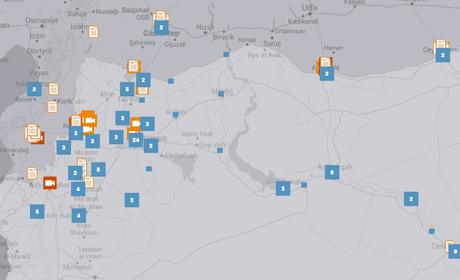'Borderlands', published in English and Turkish, maps incidents along the border from August 2012 to September 2013, plotting articles and news videos from the Wall Street Journal, YouTube videos verified by Storyful and portraits of individuals filmed by reporters and correspondents in Turkey.

A screenshot of the Borderlands interactive
"We fled when I was eight months pregnant. We escaped to the caves. Planes were bombing the area. I was in the cave when I went into labour," says a 24-year-old woman from Idlib province, Northern Syria.
"I'm suffering from a lot of trouble," says Ammar Martini, a doctor with 20 years experience treating patients in Syria who is one of the subjects in the Wall Street Journal Personal Portraits. He now treats injured refugees on the border.
"Most of my friends were killed by the regime," he says, in between gory footage of injuries being treated at the hospital and meals with other doctors.
Alongside Martini and the anonymous mother from Idlib province is a teacher in the refugee camps; the chairman of a Turkish transport company whose relatives' trucks were seized by fighters in Syria; a civil and criminal lawyer still living in Syria whose professional life has ground to a halt; and a Turkish entertainment reporter turned war correspondent.
"The way people understood the conflict was through the eyes of the refugee or the rebel fighter or the bearded Islamist," Joe Parkinson, the Wall Street Journal's Istanbul bureau chief, told Journalism.co.uk.
"But there are a hell of a lot of people who had more subtle but just as interesting stories who were getting caught in the middle.
"We wanted to tell those people's stories and we were looking for the best outlet that we could," said Parkinson.
"Video and this multimedia interactive gave us the perfect way to tell those stories. One long print story could have been fantastically gripping but probably wouldn't have taken people to the territory, let them see the complexity for themselves and let them actually take ownership of the story."
Letting the reader explore the story
As well as giving readers a geographical view of the area and how the story has progressed over time, the map provides a layered view of the conflict, said Neal Mann, multimedia innovations editor at the Wall Street Journal, who led the project from the production side.
"We very much wanted to give someone an experience of how much depth there actually was," he told Journalism.co.uk.
"The key thing is being able to get the user into a story like this and then give them the option to choose what they want to experience while still giving them enough context."The key thing is being able to get the user into a story like this and then give them the option to choose what they want to experience while still giving them enough contextNeal Mann, WSJ
The traditional news articles, videos from WorldStream, WSJ.com's microvideo hosting site, personal portraits of individuals and videos from social media give a rounded view and let the reader understand different parts of the video at their own pace, he said.
Rather than a documentary, said Mann, this is something the reader can leave and then come back to.
"Traditionally we would give someone a linear story but this was an attempt to produce something in a non-linear style, while still giving them a narrative," he said, "and then allow them to go off and engage in different parts."
For Mann, giving the audience a range of options so that each person can find what is particular to them is the key function of multimedia interactives such as Borderlands and the recent Obamacare video, and represents a change in how organisations can think about telling stories and engaging their audience.
"Can we produce something that allows people to engage with and go deeper if they want?" he said. "That's a really important thing moving forward in journalism because we have to go out there and capture the audience, get them to engage with our content and then really keep them there and keep them engaged. It's a really important way we have to change our thinking."
Free daily newsletter
If you like our news and feature articles, you can sign up to receive our free daily (Mon-Fri) email newsletter (mobile friendly).
Related articles
- 38 mojo apps from BBC trainer Marc Blank-Settle
- The Wall Street Journal launches archived content newsletter
- From problem solver to innovator: how bridge roles have evolved in newsrooms
- How to create viral news videos
- Robin Kwong, new formats editor of The Wall Street Journal, on evolving bridge roles









